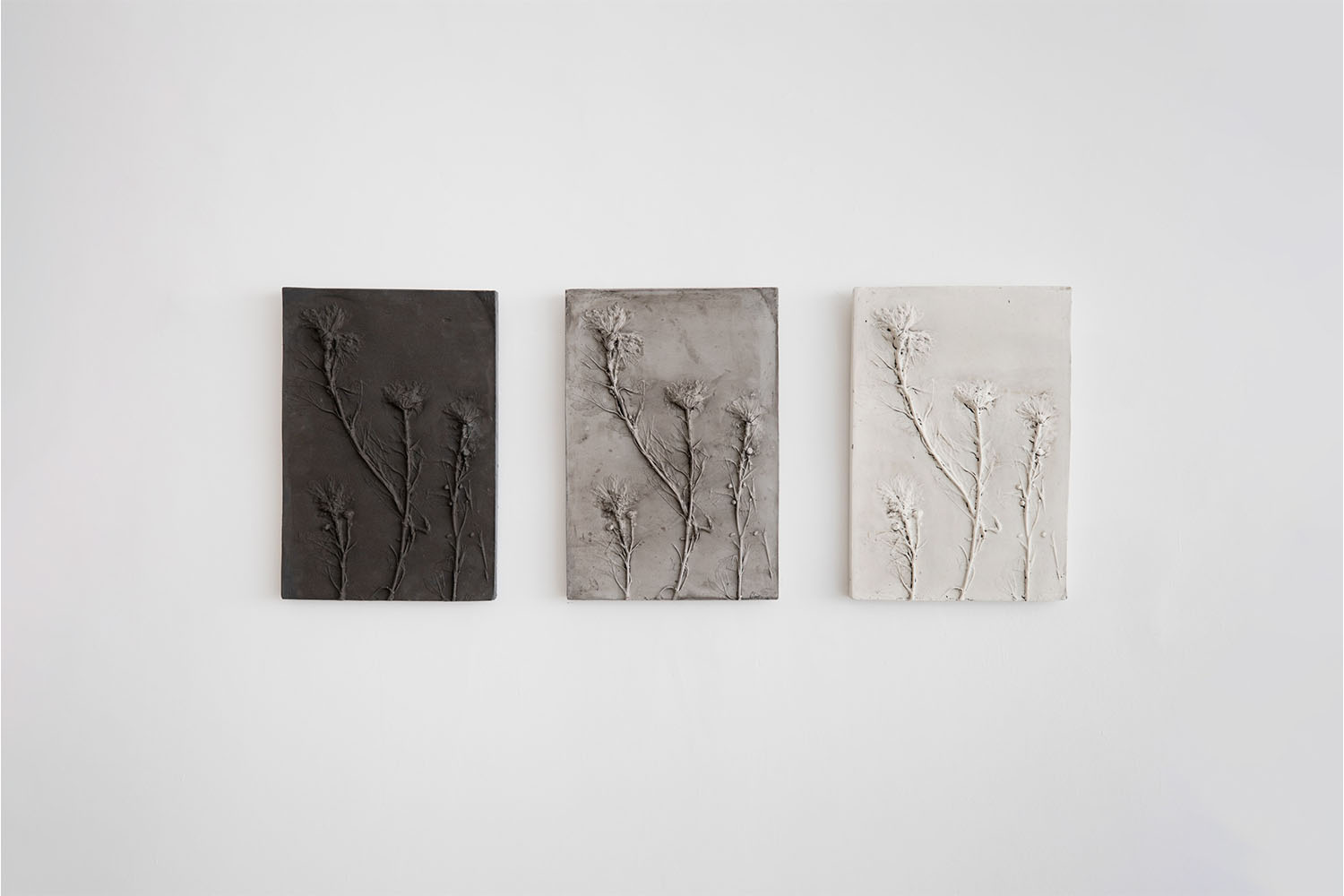Karola Braga and Licida Vidal
stories from the land
May 6, 2023 – June 22, 2023
Galeria Luis Maluf
Peixoto Gomide, 1887
histórias da terra
“todo ser vivo é a terra dos outros. Cada espécie é o terreno de vida de um número indefinido de outros atores – vivos e não vivos” Emanuele Coccia
“Let the water under the sky be gathered to one place, and let dry ground appear.” The sentence from the first book of the biblical series, entitled Genesis, brings us back into confrontation with one of the countless versions of the beginning of everything, of life and death. From the life cycles of which we are all a part, sprout disparate ideas, which mostly start from darkness. From the time when we have no memories, from the chapter when we were cocoons, before our first metamorphoses, everything was pitch. We were born from the night, and it is only from the night that we are aware of the light. According to the native peoples, especially the Guarani Mbya, the mother is darkness and it is through her that everything takes shape. We break through layers of earth, skin and husks toward life, for which we will fight until our eternal return to earth. The exhibition Earth Stories and the works presented by Karola Braga and Licida Vidal at the Galeria Luis Maluf are about the relations between meanings, memories, permanences, and life courses that are always in constant transformation.
As the Italian philosopher Emanuele Coccia explains, “ Each species, including the human species, is the metamorphosis of all those that preceded it – the same life, cobbling together a new body and a new form in order to exist differently”. With this thought in hand, the exhibition that unfolds before the spectator is naturally divided into three moments in which Braga and Vidal reflect and materialize in art their respective ways of seeing what vital stages are essentially made of.
In the first room, the beginning is presented through a site-specific installation created by Vidal in which the São Paulo artist floods the exhibition space according to its topography in order to put us at the mercy of the experience of origin, between sky and sea. In a solution with bio-fertilizer, two suspended ceramic sculptures partially float in the aquatic redoubt. Beside them, negatives of beings from the vegetable kingdom produced in plaster and pigmented by Karola Braga, from São Paulo, reconstruct this beginning. From the work displayed on the wall of the space, a sumptuous petricor exudes, a smell of wet earth, which allows us to access an infinity of memories related to the birth of several species and beings. The connection with the sensitive is immediate and it is in this room that a journey of experience and exchange between artist and visitor begins.
From the olfactory and visual experience, we arrive at the second moment of the show, in which the structures of both artists clash. On one side, Braga’s natural representations are penetrated by a milder and grayer chromaticity and reverberate around them the smell of the forest, humid and rustic, which brings in itself references to the maturity of a body in full vigor. It is important to point out the broadness of the olfactory artist’s research, which moves through different visual supports in order to take us to the poetic realm of absence, presence, and everything that smell comes to represent in the human mind. On the other hand, Vidal’s sculptural structures go against his natural nook. Made of ceramic, which is nothing more than earth undergoing a profound transformation from the exposed temperature, they acquire almost animal-like forms that run down the wall.
Such a preamble flows into a white room majestically created by Karola Braga. In it hovers the smell of loss, of mourning, of that which inevitably goes out despite our incessant attempt to contain it. Its essence seeks materialization through a site specific that puts us back in space, immersed in a reflection about what is beyond the earth, perhaps beyond life. If in Western culture the color black is associated with death and darkness, with fear and suffering, in Eastern teachings this thought is inverted, placing white as the key tone for the transcendental moment of passage to which we will all inevitably be subjected. The room becomes a sanctuary about time and memory.
All knowledge of oneself is always a knowledge of other life forms, because each life form is a collage of species. From this collage arise the seeds, which Licida Vidal places in the last exhibition room on the soles of her feet. Around the exhibited photograph is the impossibility of water, which overflows at the beginning of the show. In an installation made up of ceramic plates, the artist reassembles the ground punished and cracked by the drought that devastates our world. If “nature creates forms, apparently different, by simple modifications of a single organ,” as Goethe (1749-1832) said, this visit is an inexorable cycle of our present, past, and future. Of a single organ that passes through the infinite possibilities of life.
Ana Carolina Ralston
curator
